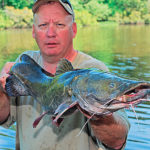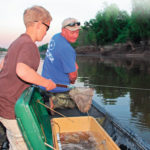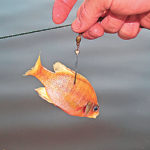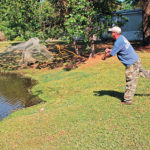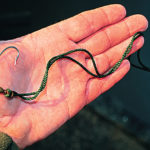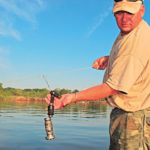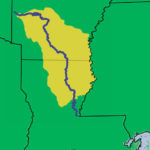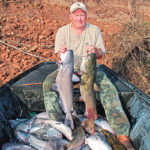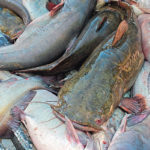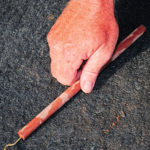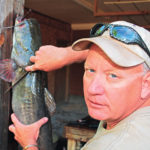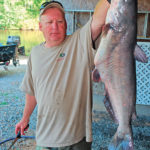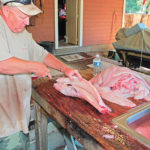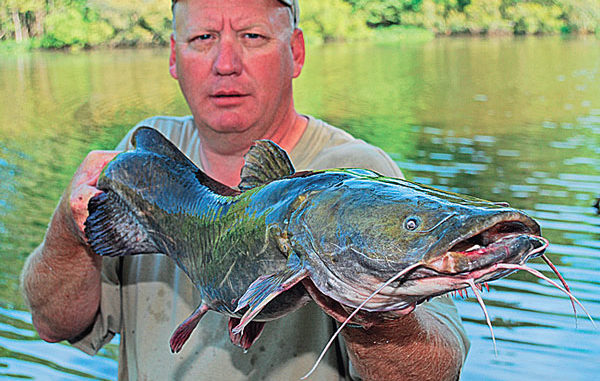
This Ouachita River regular knows that hardly a fish in America tastes better than a Louisiana flathead.
Sgt. Duane Taylor sat in the chilly morning air listening to volleys of shotgun blasts in the greentree reservoir on Russell Sage Wildlife Management Area.
After the daylight flurry of activity, the 44-year-old veteran game warden planned to run his Go-Devil-powered boat to check the groups of duck hunters that he had located by sound of their shooting and calling.
He wasn’t in any hurry. Going in early might interfere with the hunters during that critical first half-hour shooting period. Besides, some of the best mallard hunting in the flooded timber will take place after 10 a.m.
So he listened, waited and made small talk with his partner John Volentine.
“I’m looking forward to this spring when I can run my trotlines for big ops in the Ouachita River,” he said. “That’s probably my favorite kind of fishing, and I have a recipe for them that can’t be beat. My friends have a professional griddle, and I cook ‘em on that with a crispy cashew crust.”
The “op” that Taylor referred to is the flathead catfish, a fish with more aliases than a professional felon. Op is an abbreviation for Opelousas catfish, but the critter is also called a yellow cat, a tabby cat, a goujon, a mud cat and a shovelhead cat, amongst other names.
The fish is so ugly it’s beautiful. It is generally a mottled yellow to olive in color. It has tiny beady eyes set far apart on a head that is so flattened it looks like an 18-wheeler ran over it, then backed up to see what it hit. It gets big too; 123 pounds, 9 ounces is the IGFA all-tackle record.
It’s a professional mugger, making its living by lurking under or near sunken tree stumps and other cover, and ambushing other fish. This one never scavenges offal like its other catfish cousins. Its diet of living fish may account for its sweet succulent flesh.
In the second week in April, I got the call from Taylor.
“It’s freezer-fillin’ time,” he said. “I got the week off.”
I was out like a cannon shot, heading for Taylor’s home in West Monroe.
When I got there, I found him already in the process of catching live bait, the only thing that his finicky targets would eat. He repeatedly threw a cast net into a small privately-stocked pond. After each throw, he would dump the contents of the net on the grass, and his son Will would rummage through the sticks, aquatic grass and water bugs to pick out the small bluegill that they would use for bait. Most prized were those that were small enough to fit comfortably in the palm of a hand.
Taylor was wearing a huge, face-splitting grin, and his blue eyes were twinkling, but his son was distinctly glum.
“He’s got to go to school tomorrow, and he’s madder than a wet hen,” the elder Taylor explained. “But he’s gonna get to help us bait lines today.”
The youngster didn’t seem impressed.
After what seemed like many dozens of bream (the local name for bluegill and other sunfish, and always pronounced “brim”) had been dumped in the big pump-equipped ice chest that served as the live well in their boat, the three of us set out for Lazarre Point Boat Landing. The elder Taylor expressed concern that he wouldn’t have enough live bream to bait all 300 of his hooks.
Taylor launched his aluminum flatboat, and headed downriver. The spring air was pleasant and warm in the waning afternoon sun, and the Ouachita River smelled like only a big river like the Mississippi, Atchafalaya or Red can — dank but alive, musty but fertile. The white sandbars in the inside of each bend in the river gleamed brightly in the evening sun.
Taylor pulled over to an unmarked spot on one bank that looked just like any other. He snaked his 8-foot gaff overboard to hook the first of the 10 trotlines that he had put out earlier in the morning.
“I tie them off to a tree limb or stump underwater to keep people from finding my line and stealing my catch or even the whole line,” he explained.
He deftly hand-over-handed the horizontal line while standing on the bow deck of the boat. Hooks on short dropper lines were spaced about 6 feet apart.
Will scooped wiggling bream out of the livewell with a dip net, and handed them to his father to put on the hooks. Each bream was hooked through the body directly beneath its dorsal fin.
The two went from trotline to trotline repeating their drill. Taylor chatted as he baited hooks.
“I’ve been running trotlines in this river for catfish for 25 years,” he said. “I learned a lot from my uncle, Hooper Nealy. He says that if you can’t catch a catfish on the full moon in June, you need to take up golfing or something else. He is in his 70s and is still running trot lines.”
He shifted the talk to the table qualities of his favorite fish.
“We will either catch ops and blue cats mixed, or it will be mostly blue cats,” he said. “Yellow cats [another term of his for ops] are my favorite. They have a pinkish meat that is a lot sweeter than any other fish, including white perch.”
He shot me a stern look to punctuate his last statement, almost challenging me to disagree.
“It goes by a lot of names, but I call it delicious,” he said. “To me, it is the best-tasting fish that swims in fresh water — especially the belly. Take one 8 to 15 pounds, you can’t get anything better.”
Things looked promising. While they were baiting the lines, they unhooked three blue catfish from hooks that hadn’t even been baited yet. After baiting three lines, Taylor stopped and ran the dip net through the live well. We would only have enough bream to bait alternating hooks on the last seven lines, he declared.
Before starting the last line, he recalculated his bait supply and found that he had enough bream left to bait every hook on the line.
“Maybe it will be a good one,” he said hopefully.
At 7:25 p.m., after hooking on the last bait and letting the line snap back into the water, Taylor paused to take in the peaceful setting. The long rays of the setting sun softened the landscape and colored the normally white sand bars with a hint of mauve. A houseboat passed us, heading downstream, its passengers echoing laughter across the quiet water.
The next morning, tension ran high. The normally talkative Taylor, now minus his son, was quiet. As the small boat clipped through the misty and nippy morning air, he threw a knowing look at me and crossed the fingers of both hands. He grinned slightly.
Three hooks into running the first line, he got excited.
“I see bubbles!” he said. “Got an op — about an 8-pounder.”
While unhooking it, he purred in satisfaction.
“I feel another,” he said. “It feels like a blue.”
Later he explained that a hooked op releases bubbles as it nears the surface. Blue cats pull in short jerks. Long surges mean big ops, the kind that make bubbles the size of saucers.
The line yielded three more catfish, all blues. Blue catfish under 5 pounds are unceremoniously flipped into the boat unless they are poorly hooked. A landing net is used on bigger blue cats and all ops.
As soon as he picked up the next line, he felt the tug of a hooked fish.
“I feel ya down there,” he said with a grin.
The line gave up four more blue catfish, two of them hefty and one op of about 12 pounds.
Near the end of line No. 3, which produced three blue catfish, he bemoaned his bait shortage of the previous day.
“Oh, if we woulda just had enough bait.”
The comment was a lamentation tinged with excitement.
The fourth line had all the bait still on the hooks and no fish. The line was hung up a little over halfway to the end, probably on a sunken treetop. The baits never got to the bottom ,and the result was no catch.
He shrugged philosophically and ran the boat to line No. 5. This one had no fish and no bait left either. He looked perplexed. The line was a “crossing,” which meant that it spanned the entire width of the river, and was tied at the bank at both ends. He ran his boat to the other bank, grabbed the other end of the line and ran it from that end out toward mid-river, hoping that the tactic would un-hang it. It didn’t, and it held only one small blue catfish.
After he grabbed the sixth line, he rested the taut nylon over his knee, reached into his pocket, took out his Grizzly Snuff and put a pinch of it in his mouth, like he was trying to change his luck. He rested his hand on the pulsing line and declared authoritatively, “blue cat.” He paused a moment and then added, “two of ‘em.”
And indeed, the first hook held a sway-bellied big girl. Then the third hook produced another one, then the fourth hook, then the fifth hook.
“That’s a lot of blue cats,” I chirped cheerfully.
Line 7 produced five blue catfish and no ops. Not bad, but nothing to get Taylor excited.
He stepped to the back of the boat after he let go of the line, sat down and cranked the motor.
“We got a good bit over 100 pounds — and we got three more chances,” he said. Confidence rang in his voice.
The next two lines were a disappointment. They produced one small blue cat between the two of them. It seemed that the farther up the river we went, the fewer fish we caught. Everything now rode on the last line, the one farthest upriver.
It was a jackpot! It seemed like every hook held a fish. Taylor gave his small homemade de-hooking stick a workout. The final tally for the line was four ops and 12 blue catfish.
We were off the water by 8:30 a.m. while the spring night’s freshness was still in the air.
Back at Drew Mobile Home Park shop, owned by his friends L.C. and Glinda Jenkins, Taylor went to work. He had fish to clean and a lot of them. First order of business was to get a gallon plastic zipper bag of blue cat fillets cut into 1-inch cubes for Glinda’s kitchen. Her famous catfish courtbouillon would take time to prepare.
That done, he set to work methodically skinning, prepping and weighing what ended up being 19½ pounds of pure op fillets and bellies and 40½ pounds of blue catfish fillets.
That evening, between alternating bites of Glinda’s courtbouillon and Taylor’s griddle seared cashew-crusted op bellies, I thought of his smug grin as he half-turned and looked over his shoulder while cleaning an op and said, “This is like skinning sugarcane.”
